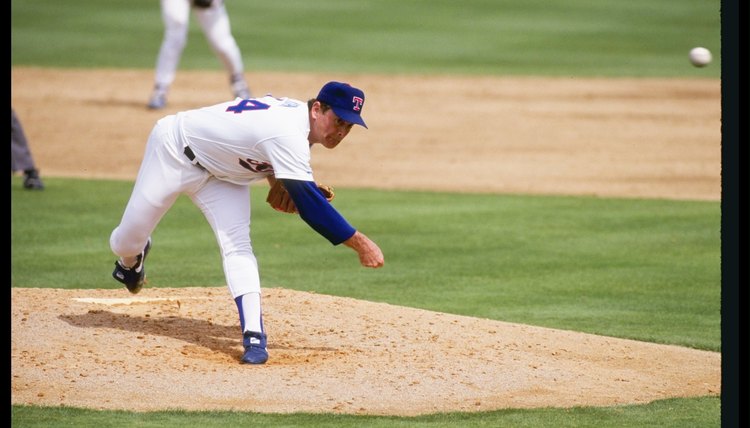How to Calculate Miles Per Hour in Pitching

The “fastest pro pitcher of all time” will inevitably change over the years as records are eventually broken by the latest and greatest, and the point will ever be contested eternally by players, fans, historians and researches. All-time great Nolan Ryan’s rocketing Aug. 20, 1974, fastball pitch against the Detroit Tigers was entered into the Guinness World Records “officially” at 100.9 miles per hour. According to power-hitting Hall of Famer Reggie Jackson, "Every hitter likes fastballs just like everybody likes ice cream. But you don't like it when someone's stuffing it into you by the gallon. That's how you feel when (Nolan) Ryan’s throwing balls by you.” Surprise your friends at the next game by calculating pitching miles per hour using simple math that’s easy enough for a middle school kid to learn.
Measure the distance from where the ball will be thrown to home plate with a tape measure. It’s 60.6 feet to the plate from the pitcher’s mound on a Major League diamond, but the distance varies between leagues and playing levels.
Clock the pitch’s travel time with a stopwatch. This is the time that it takes for the ball to travel from the pitcher’s hand to when it reaches home plate -- a half second, for example.
Calculate the average speed of the pitched ball with the equation S = D / T. The speed in feet per second is represented by S, the travel distance is D, and the time it took for the pitch to reach the plate is T. The pitch’s speed in this example is 60.6 / 0.50 = 121.2 feet per second.
Divide the seconds in an hour (3,600) by feet per mile (5,280). The conversion ratio is 0.682. Convert the pitch’s speed per second into miles per hour using the formula M = S x (3,600 / 5,280). M represents the ball’s speed in miles per hour, with S being its speed in feet per second. The speed in this example is formulated as 121.2 x 0.682 = 82.65 miles per hour.
Figure the pitch’s speed in miles per hour directly from its travel speed in seconds and the distance. Though slightly more involved, it’s a bit quicker. In the equation M = (D / T) x (3,600 / 5,280), M represents the speed in miles per hour, D represents the distance in feet and T represents the travel time in seconds. This formulation for the pitch’s average speed is (60.6 / 0.50) x (3,600 / 5,280) = (121.2 x 0.682) = 82.65 miles per hour in this example.
References
- CSG Network: Baseball Pitching Speed Calculator
- Calculate Me: Convert Feet Per Second to Miles Per Hour
- MLB.com: Official Info -- Baseball Basics: On the Field
- Baseball Almanac: The Fastest Pitcher in Baseball History
- Baseball Hall: Jackson, Reggie
- Baseball Almanac: Nolan Ryan Quotes
- Bleacher Report: Nolan Ryan’s Seven No-Hitters
- YouTube -- ThisDayInBaseball: Nolan Ryan Reaches 3,000 Strikeouts
Resources
Writer Bio
A full-time writer since 2007, Axl J. Amistaadt is a DMS 2013 Outstanding Contributor Award recipient. He publishes online articles with major focus on pets, wildlife, gardening and fitness. He also covers parenting, juvenile science experiments, cooking and alternative/home remedies. Amistaadt has written book reviews for Work At Home Truth.
